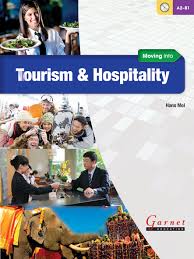Moving into Tourism and Hospitality

This three-component course is intended for college and/or university students who are pursuing a career in tourism or hospitality. The components of the course are written by Hans Mol and Anna and Terry Phillips, who are experienced English teachers, trainers, and writers.
As indicated in the coursebook, the level of the course meets the CEFR criteria of A2 to B1 levels, and the contents are divided into 10 units plus two extra review units in the middle and at the end of the book.
The coursebook’s style and layout are simple but very visually attractive from the very first page. One of the most striking and most interesting aspects of the book is that although the index helps the teacher and students know exactly what they are going to teach and learn, each unit is organised at random, i.e., each unit does not follow the same structure in the same order. The only sections whose order are fixed are the Preview Lesson, which presents visually the key vocabulary the students will learn in the unit; and Over to You, which is a final double-page activity which helps the students and teacher to review the linguistic features and skills of the unit.
Another significant feature of the book is that the content is organised around the four skills necessary to master a language specifically related to the tourism industry. Those skills are carried out individually and the focus of each skill is indicated in the Skill Box included not in every section but in the writing subsections.
As the contents are organised thematically by skill set, the grammar is integrated within them. All the skills included in the book have a Grammar for … (listening, reading, speaking, writing) section which gives the students the key points to consider when doing the activities of the required still. Of course, there is a Grammar Reference section at the end of the book which gives extra explanation of the key grammatical points. In this way, the focus is not so much on the theoretical part of studying a language but rather on the practical application of language in each of the skills any students should master, taking into account the level of proficiency required to carry out this course.
Thus, the activities included in the book are not mainly intended to acquire the skills of the English language and English grammar individually but rather as an integrating and engaging application of the knowledge acquired. Therefore, the activities can apply what they have learnt in their daily activities as well as in their professional careers. One of the strengths of the book is that it presents a balance between individual work, pairwork and groupwork.
Another point of praise must be made to the section English in action, which deals with functional and practical language necessary to work in the Tourism and Hospitality industry, as well as conducting a business such as leaving and taking messages on the phone, talking about prices or arranging a meeting.
One of the key sections of the coursebook is Over to You which represents a final activity or rather a final project which the teacher can assess to review the students’ progress. This section is focused on the vocabulary and skills acquired throughout the unit. I personally recommend teachers to use this final section as a final project, which starts as homework as some research needs to be done for one of the activities. In the classroom, the students, either individually, in pairs, or in groups, could deliver the project as a follow-up activity as it integrates the skills and linguistic features acquired in the unit. Also, this section includes a self-assessment subsection mirroring the can-do statements of the CEFR. Thus, the students will know their strengths and weaknesses, which in case of the latter they may turn to the workbook to complete and ‘fill in the gaps’ of their knowledge.
The workbook provides additional language practise and includes extra listening practises as a CD is included in the package. Teachers can use the workbook either as a reinforcement of the contents from the course in the classroom for the students or rather as self-study material for the students along the course as the transcripts and key to the exercises are included in the component.
The Teacher’s Book is well-written and provides a clear explanation about the different activities included in the coursebook, apart from the key to all the tasks. Personally, I do not miss any extra resource ideas or activities as the book presents enough individual, pairwork, and group activities integrating all the skills necessary for the students at this level.
Maria Elena Serrano
